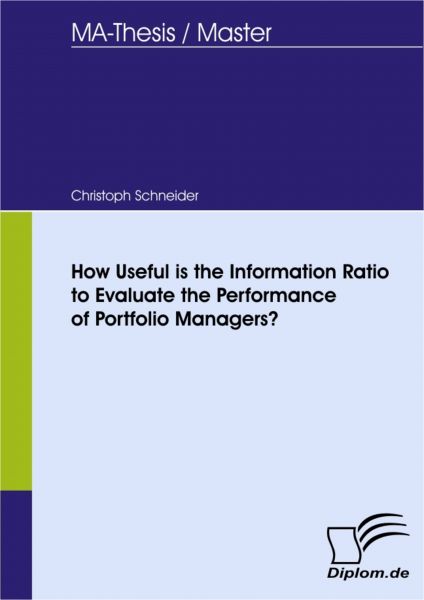How Useful is the Information Ratio to Evaluate the Performance of Portfolio Managers?
Inhaltsangabe:Abstract:
„I do not want a good General, I want a lucky one.” (Napoleon Bonaparte).
In contrast to Napoleon, investors typically do not want to pick a lucky person to administer their funds, but both Napoleon and the investor face a similar problem: how to separate the lucky from the skilled. Historic data shows that five out of one hundred portfolio managers achieve an outstanding performance just by luck, and statistics also reveal that luck – in most cases – does not persist over time. The lucky managers will, however, always cite their superior skills as a reason for their success, while the unsuccessful ones will place the blame on bad luck. By assessing all active managers on the two dimensions luck and skill, four groups are created. The separation of the skilled and lucky from the unskilled but lucky managers and the separation of the skilled but unlucky from the unskilled and unlucky managers is of special interest to all stakeholders in the investment industry. It is, therefore, the investor’s task to apply understandable guidelines, preferably on a quantitative basis, when it comes to evaluating a portfolio manager. On the other hand, it is the fund administration’s task to judge the performance of its managers objectively and to transfer the results into a variable remuneration scheme or to decide about the replacement of a certain manager.
The idea of comparing the performance of different risky investments, for example investment funds, on a quantitative basis dates back to the beginnings of the asset management industry and has been an important field of research in finance since then. Performance measures serve as valuable quantitative evidence for the portfolio manager’s performance as well as for the evaluation of investment decisions ex post. Based on the idea of the capital asset pricing model (CAPM) proposed by Treynor, Sharpe, and Lintner, Treynor developed the first quantitative performance measure intended to rate mutual funds, the Treynor Ratio. Since then, a large number of performance measures with very different characteristics have been developed. Besides academia, the driving force behind the development of more sophisticated performance measures has always been the investors. This is understandable, as „the truly poor managers are afraid, the unlucky managers will be unjustly condemned, and the new managers have no track record. Only the skilled (or lucky) managers are enthusiastic”.
By combining and […]
Inhaltsangabe:Abstract:
„I do not want a good General, I want a lucky one.” (Napoleon Bonaparte).
In contrast to Napoleon, investors typically do not want to pick a lucky person to administer their funds, but both Napoleon and the investor face a similar problem: how to separate the lucky from the skilled. Historic data shows that five out of ...
Versandkostenfreie Lieferung! (eBook-Download)
Als Sofort-Download verfügbar
- Artikel-Nr.: SW9783836632065
- Artikelnummer SW9783836632065
-
Autor
Christoph Schneider
- Verlag Diplom.de
- Seitenzahl 95
- Veröffentlichung 01.07.2009
- ISBN 9783836632065
- Barrierefreiheit Aktuell liegen noch keine Informationen vor
- Verlag Diplom.de

